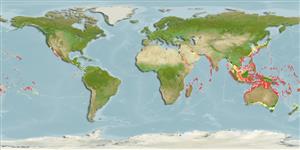Environment: milieu / climate zone / пределы глубины / distribution range
экология
морской ассоциированный с рифами; пределы глубины 0 - 55 m (Ref. 90102). Tropical
Indo-West Pacific: East Africa to Micronesia, Line Islands, and Society Islands, and Taiwan to Australia (Ref. 90102); including Papua New Guinea, Line Islands and Society Islands; Taiwan to reefs of Coral Sea and New Caledonia (Ref. 54980).
Size / Вес / Возраст
половая зрелость: Lm ? range ? - ? cm
Max length : 4.0 cm TL самец/пол неопределен; (Ref. 48636)
Краткое описание
определительные ключи | морфология | морфометрия
колючие лучи спинного плавника (общее число) : 13 - 16; членистые (мягкие) лучи спинного плавника (общее число) : 7 - 10; колючие лучи анального плавника: 1; членистые (мягкие) лучи анального плавника: 15 - 20. Identified by the tall first dorsal fin that is white in males (Ref. 48636). Large individuals may have conspicuous dark spot on upper middle of second dorsal fin connected to a band extending down the sides as well as about 5 darker bars on body and red snout and lower head (Ref. 37816).
Body shape (shape guide): elongated.
Adults are found in various reef habitats, but often on sponges or reef outcrops (Ref. 48636). Also found in intertidal pools (Ref. 13227) and on corals and rocks (Ref. 37816). They feed on zooplankton (Ref. 48636). Eggs are hemispherical and covered with numerous sticky threads that anchor them in the algae on the nesting sites (Ref. 240). Larvae are planktonic which occur primarily in shallow, nearshore waters (Ref. 94114). The most common and most widely distributed among Enneapterygius species (Ref. 90102). Minimum depth reported from Ref. 13227.
Life cycle and mating behavior
половая зрелость | размножение | нерест | икра | Fecundity | личинки
Fricke, R., 1994. Tripterygiid fishes of Australia, New Zealand and the southwest Pacific Ocean (Teleostei). Theses Zool. 24:1-585. (Ref. 13227)
Статус Красного Списка МСОП (Ref. 130435: Version 2025-1)
Угроза для людей
Harmless
Использование человеком
рыболовство: интереса не представляет
дополнительная информация
инструменты
Специальные отчеты
Скачать в формате XML
ресурсы в Интернет
Estimates based on models
Preferred temperature (ссылка
123201): 24.1 - 28.9, mean 27.5 °C (based on 802 cells).
Phylogenetic diversity index (ссылка
82804): PD
50 = 0.5000 [Uniqueness, from 0.5 = low to 2.0 = high].
Bayesian length-weight: a=0.00617 (0.00288 - 0.01322), b=3.04 (2.86 - 3.22), in cm total length, based on LWR estimates for this (Sub)family-body shape (Ref.
93245).
Trophic level (ссылка
69278): 3.4 ±0.45 se; based on food items.
устойчивость к внешним воздействиям (ссылка
120179): высокий, минимальное время удвоения популяции до 15 месяцев (Preliminary K or Fecundity.).
Fishing Vulnerability (Ref.
59153): Low vulnerability (10 of 100).
🛈
Nutrients (Ref.
124155): Calcium = 433 [156, 1,848] mg/100g; Iron = 2.47 [0.83, 5.79] mg/100g; Protein = 18.1 [16.2, 19.9] %; Omega3 = 0.108 [0.024, 0.510] g/100g; Selenium = 89.7 [15.6, 432.6] μg/100g; VitaminA = 35 [4, 270] μg/100g; Zinc = 5.59 [2.35, 10.78] mg/100g (wet weight);
